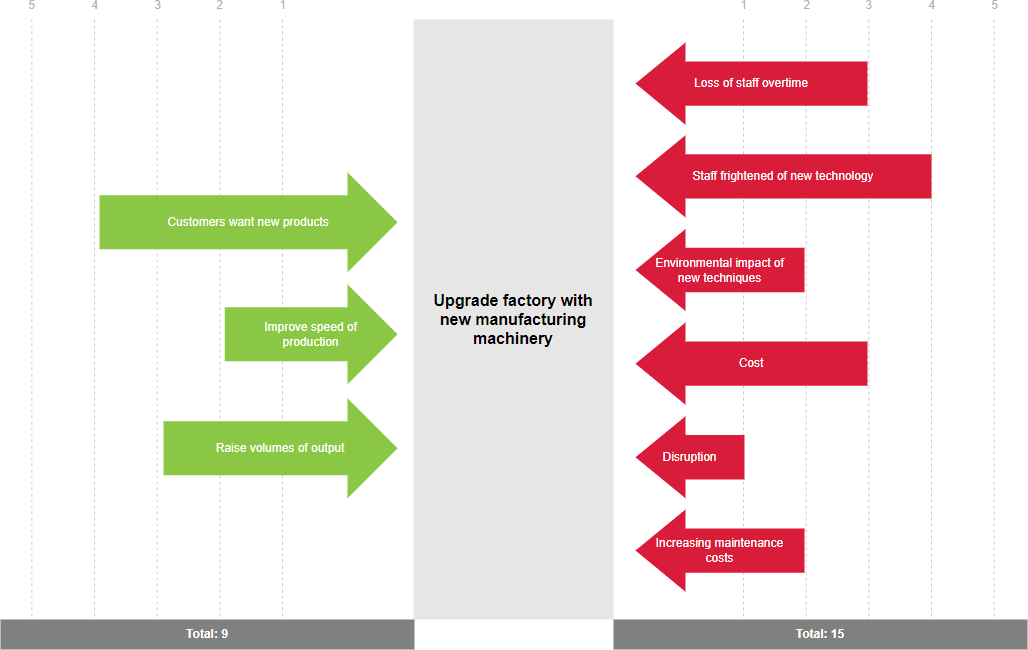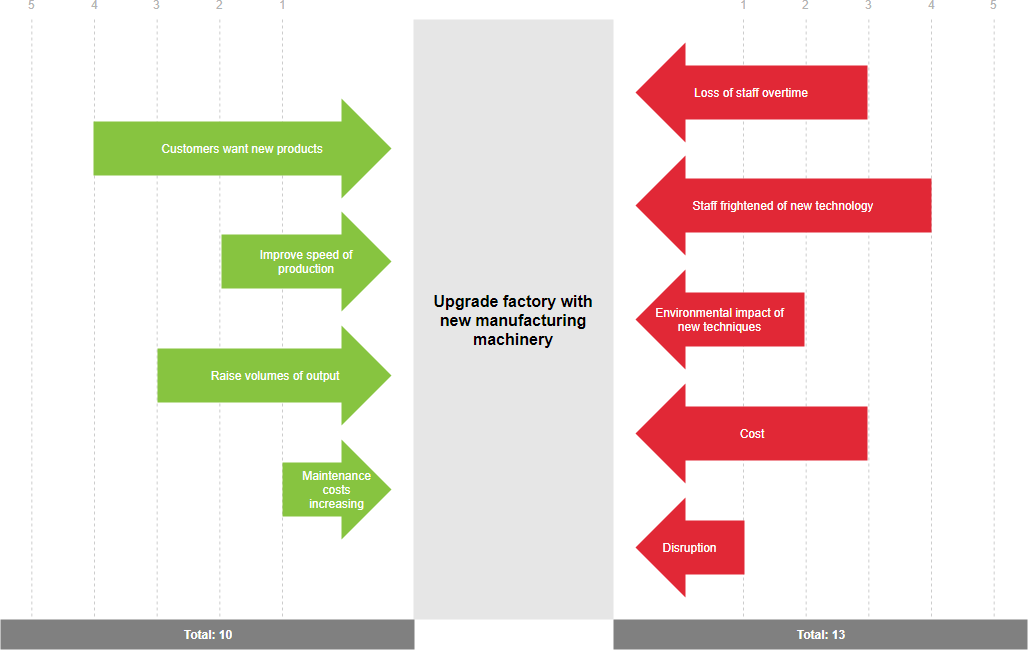Introduction
Force Field Analysis (FFA), developed by Kurt Lewin in 1951, is a widely used tool for informing decision-making, especially in the context of change management within organizations. This powerful method provides a comprehensive overview of the various forces acting on a potential change initiative, allowing organizations to assess the sources and strengths of these forces. By clarifying the ‘driving forces’ that support change and identifying the ‘restraining forces’ that act as obstacles, FFA enables organizations to prioritize factors influencing the change process.
Understanding Force Field Analysis
Force Field Analysis is particularly useful for bridging research and policy. It can analyze the forces affecting a situation or evaluate the conditions under which specific research might be adopted as policy. Moreover, it helps identify where research can help shift forces towards achieving desired change.
Key Components of Force Field Analysis
- Driving Forces: Factors that support or promote change, such as market demand, stakeholder support, and potential benefits.
- Restraining Forces: Factors that hinder or oppose change, including resistance from employees, resource limitations, and potential negative impacts.
How to Conduct a Force Field Analysis
Carrying out a Force Field Analysis typically involves a collaborative approach, often using a flip chart or whiteboard. Here’s a step-by-step guide:
Step 1: Describe Your Plan or Proposal for Change
Begin by discussing the current situation with your team and agree on the goal of the proposed policy or change initiative. Clearly write this goal in the center of the chart, with two columns on either side to represent driving and restraining forces.
Step 2: Identify Driving and Restraining Forces
Next, brainstorm the forces for and against the change. List the driving forces in one column and the restraining forces in the other. Group similar forces together to identify common themes.
To quantify the impact of each force, assign a score ranging from 1 (weak) to 5 (strong) for both driving and restraining forces based on their magnitude and influence on the change process.
Step 3: Review Results and Develop an Action Plan
The final step involves discussing the results with your team. Focus on developing action strategies to minimize the restraining forces and enhance the driving forces. This collaborative discussion often yields insights into potential solutions and a clear action plan moving forward.
Example of Force Field Analysis
Here’s a simplified example of what a Force Field Analysis table might look like for a proposal to upgrade a factory with new manufacturing machinery:

| Driving Forces | Restraining Forces |
|---|---|
| Customers want new products (Score: 4) | Loss of staff overtime (Score: 3) |
| Improve speed of production (Score: 2) | Staff fear of new technology (Score: 4) |
| Raise volumes of output (Score: 3) | Environmental impact of new techniques (Score: 2) |
| Cost of implementation (Score: 3) | |
| Disruption during transition (Score: 1) | |
| Increasing maintenance costs (Score: 2) | |
| Total Score: 9 | Total Score: 15 |
Using the scores from a Force Field Analysis helps quantify and prioritize the driving and restraining forces in a decision-making process. Here’s how to effectively use the scores:
Steps to Use the Scores
- Assign Scores: Each driving and restraining force is typically assigned a score based on its perceived strength. Scores usually range from 1 to 5, where:
- 1: Weak influence
- 5: Strong influence
- Calculate Totals:
- Sum the Scores: Add the scores of all driving forces to get a total driving score.
- Sum the Restraining Scores: Similarly, add the scores of all restraining forces to get a total restraining score.
- Analyze the Balance:
- Compare Totals: Evaluate the difference between the total driving score and the total restraining score.
- Positive Balance: If the driving score is higher, it indicates a favorable environment for change.
- Negative Balance: If the restraining score is higher, it suggests significant challenges that need to be addressed.
- Identify Key Forces:
- Focus on High-Impact Forces: Look for the forces with the highest scores. These are the most influential and should be prioritized in your strategy.
- Consider Low-Impact Forces: Forces with low scores might require less attention but can still be monitored.
- Develop Action Plans:
- Enhance Driving Forces: Create strategies to strengthen the driving forces. For instance, if customer demand is a significant driving force, invest in marketing or product development.
- Mitigate Restraining Forces: Develop plans to address the restraining forces. For example, if staff are afraid of new technology, implement training programs to ease their concerns.
- Monitor and Adjust: After implementing changes, continuously monitor the situation. Reassess the scores and adjust your strategies as necessary to ensure the change initiative remains on track.
Interpretation of Net Score
- Positive Net Score:
- Implication: Indicates that the driving forces outweigh the restraining forces.
- Action: This suggests a favorable environment for change. Consider moving forward with the proposed change initiative, while still monitoring the restraining forces to ensure they don’t escalate.
- Negative Net Score:
- Implication: Indicates that the restraining forces are stronger than the driving forces.
- Action: This signals significant challenges. It may be necessary to address these restraining forces before proceeding with the change. Focus on strategies to mitigate these obstacles.
- Zero Net Score:
- Implication: The driving and restraining forces are balanced.
- Action: This indicates a neutral position. While the change might be feasible, it’s essential to strengthen driving forces or reduce restraining forces to create a more favorable environment.
Summary of Actions Based on Interpretation
- Positive Net Score:
- Proceed with the change.
- Monitor and reinforce driving forces.
- Negative Net Score:
- Delay the change initiative.
- Develop strategies to reduce restraining forces.
- Zero Net Score:
- Assess and strategize to tip the balance in favor of change.
By analyzing the total score, organizations can make informed decisions regarding change initiatives and strategically plan their next steps.
Conclusion
Force Field Analysis is an invaluable tool for organizations seeking to implement change effectively. By thoroughly assessing the driving and restraining forces, teams can develop informed strategies that enhance the likelihood of successful change initiatives. This structured approach not only clarifies the dynamics at play but also fosters collaboration among stakeholders, leading to more effective decision-making.
Implementing Force Field Analysis in your organization can help you navigate the complexities of change management and lay the groundwork for successful transformation.
